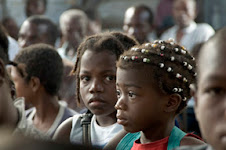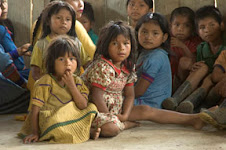The middle two weeks of November were very busy for me, but not in El Chocó. I spent most of one week in Medellín, where I gave three talks about El Chocó at the Centro Colombia-Americano, one for the general public (I’ve put a copy of the invitation below) and two for Martin Luther King Fellows. And I was able to take advantage of this invitation, prompted by a suggestion from the US Embassy, to visit friends in Medellín and get to know the city a little better.
The Martin Luther King Fellowship is interesting. It’s a grant to help selected Afro-Colombian students move on in their studies and eventually study in the US. My understanding is that it’s funded by the US Embassy and administered by the Colombo-Americano. I’ve spoken to a group in Bogotá and in Medellín, and soon will give a talk to a group here in Quibdó.
After the question and answer period following each talk, I put the following question to them, and I’ve been struck by the fact that none of the fellows so far has known the answer: Why is there an MLK Fellowship? Where did it come from?
They tend to answer by explaining what they expect the fellowship to do for them; that is, they know the goals of the program. But, I ask them, Why did the embassy decide to do this? Generally, there’s no answer, although one young fellow said, “To honor Dr. King.” My next question is, this program is barely 1½ years old. Why did it take them nearly 38 years after his death to honor Dr. King?
The answer is, of course, that this program grew in response to pressure from the Congressional Black Caucus on the embassy that they “do something for the Afro-Colombian people.” But then the question is, “Why did the Black Caucus act so recently?’ And I’m convinced that the answer is the obvious one: these members of congress acted because they began to feel pressure from people in the peace and justice movements in the US. And why did we begin to pressure them? Because after the conflicts in Central America, US foreign policy seemed very focused on Colombia, which suggested the importance of the country to many of us (it’s worth mentioning that Colombia, which receives so much aid from the US, is one of the few hold-outs in a general leftward swing in South American governments).
After Medellín, I spent nearly a week in Bogotá, invited to be part of a day-long seminar on international exchanges to celebrate 50 years of Fulbright in Colombia, and to spend a morning with a class on photography in the media at the Universidad Nacional—and again I spent time visiting old and new friends there.
The Fulbright event was quite good; it exceeded my expectations. Three panels of three people each. The first panel was on the theme of a conceptual framework for understanding international exchange, and to my delight the presentations were quite critical, and very interesting. I’ve been encouraging the Fulbright folks here to publish the presentations.
My own presentation, in the third panel, was about some considerations about photography as social communication, some traps and issues for people who want to be serious about their photography. It’s an old theme of mine, of course, but it has some particular relevance in the context of communications across cultures. I’ve decided to post it in my web pages (it’s a little long for here). If you want to read it, you can go here to see it—sorry, for the moment it’s in Spanish only, but I hope to translate it into English soon.

Actividades recientes
Las dos semanas en medio de noviembre me resultaron muy llenas, pero no en El Chocó. Pase la mayor parte de una semana en Medellín, donde di tres charlas sobre El Chocó en el centro Colombo-Americano, una para un público general (he puesto una copia de la invitación arriba), y dos para becarios de la Beca Martin Luther King. Y pude aprovechar esta invitación, motivada por una sugerencia de la embajada EEUU, para visitar a amig@s en Medellín y conocer un poco más la ciudad.
La Beca Martin Luther King es interesante. Es una beca para ayudar a un@s estudiantes afro-colombian@s elegid@s a que avancen sus estudios y al fin estudien en EEUU. Tengo entendido que es financiada por la embajada EEUU y administrada por el Colombo-Americano. He hablado a un grupo en Bogotá y en Medellín, y dentro de poco daré una charla a un grupo acá en Quibdó.
Después del período de preguntas que siguió cada charla, les puse la pregunta que sigue, y quedé impresionado que ningun@ de l@s becari@s hasat este punto ha sabido la respuesta: ¿Por qué hay una beca MLK? ¿De dónde surgió?
Tienden a contestar con una explicación de lo que esperan que la beca les vaya a hacer, o sea, saben los propósitos del programa. Pero les pregunto, ¿Por qué la embajada decidió hacer esto? Por lo general, no hay respuesta, aunque un joven dijo, —Para honrar al doctor King. Mi próxima pregunta es, Este programa tiene apenas 1 /2 años. ¿Por qué demoraron casi 38 años después de su muerte para honrar al Dr. King?
La respuesta, por supuesto, es que este programa se desarrolló como respuesta de presiones de parte de la organización de congresistas afro-americanos (the Congressional Black Caucus) a que “hicieran algo para el pueblo afro-colombiano.” Pero luego viene la pregunta, ¿Y por qué el Black Caucus sólo se movió hace tan poco? Quedo convencido que la contestación es la obvia: esos miembros del congreso se movieron porque habían empezado a sentir presiones de parte de gente en los movimientos por la paz y la justicia en EEUU. Y, ¿por qué empezamos a presionarl@s? Porque, después de los conflictos en América Central, la política externa de EEUU al parecer se enfocó mucho en Colombia, el cual a much@s de nosotr@s, indicó la importancia del país (cabe mencionar que Colombia, que recibe tanta ayuda de EEUU, es uno de los pocos países resistentes al movimiento hacía la izquierda en los gobiernos de América del Sur).
Después de Medellín, pase casi una semana en Bogotá, invitado a ser parte de un seminario de todo un día sobre el tema de intercambios internacionales para observar 50 años de Fulbright en Colombia, y a pasar una mañana con una clase sobre la fotografía en los medios de comunicación a la Universidad Nacional—y otra vez ocupé tiempo visitando a viej@s y nuev@s amig@s allá.
El evento Fulbright fue bastante bueno, mejor que había esperado. Tres paneles de tres personas cada uno. El primer panel trató el tema de marcos conceptuales para entender intercambio internacional, y quedé contento con las presentaciones, que fueron bastantes críticas, y muy interesantes. He estado animando a la gente del Fulbright acá a publicarlas.
Mi intervención, en el tercer panel, fue sobre unas consideraciones en cuanto a la fotografía como comunicación social, unos escollos y asuntos para gente que quiere ser sería en su fotografía. Es un tema viejo mío, por supuesto, pero tiene una relevancia en el contexto del tema de comunicaciones a través de las culturas. Si la quieren leer, pueden ir a verla acá. Por el momento, sólo en castellano, pero espero traducirla al inglés dentro de poco.


1 comment:
Mi estimado amigo,
Muy buenas las notas de tu charla.
Sobre la asimetría de acceso desde una cultura a la otra, que hace imposible intercambios verdaderos, habría que definir a qué llamamos "intercambios verdaderos". Pero, sin entrar en ese espinudo tema, te destaco un aspecto muy potente de intercambio cultural que de seguro tú estás realizando, pero no mencionas en la charla.
En esta charla, en un ambiente académico, tú analizas tu proceso de acercamiento a tu trabajo y al pueblo, las personas que tienes por delante, y a las que tienes por detrás.... (como yo), los consumidores del producto de tu trabajo. De esta manera, tu análisis nos ayuda mucho a comprender tu trabajo y las imágenes mismas. Pero, tú estás, también, como en este blog, presentando a tus sujetos tu proceso de descubrimiento de su cultura. Lo que te llama la atención, lo que te sorprende (sobre todo cuando estás comprendiendo lo básico), puede ser de gran valor para tus sujetos. Me refiero a observaciones con un grado de comprensión superior al caso de los moteles o de un marco de espejo sin espejo. Por ejemplo, te sorprenden aquellas familias de (no recuerdo el nombre del poblado) que prefirieron construir sus casas junto a sus campos de labranza, a pesar de tener que caminar mucho con los materiales para sus casas. Allí, cuando les planteas "pero han debido caminar mucho con cada cosa...", su respuesta de que "sí, es cierto, pero valió la pena", les proporciona un momento de autoexamen, y, en este caso, de seguro un reforzamiento de sus opciones de vida. En estos encuentros, la imagen de sí mismos que les vas construyendo a la gente de El Chocó es, de seguro, una potente forma de intercambio cultural. Así, tú eres la antítesis de aquel marco sin espejo. El concepto vulgar del fotógrafo, sobre todo del documentalista que nos viene a "estudiar", es de un vehículo, esencialmente neutro, que sólo transmite hacia su cultura de origen. Sin embargo, el sujeto que miró tu lente, creyendo ver sólo un mecanismo succionador de su imagen tal-cual-es, se encuentra de pronto con que había allí también un espejo, que le devuelve un aspecto insospechado de su propia imagen.
Ricardo.
********************************************
My dear friend,
I enjoyed your notes on your talk.
Regarding the asymmetry, that you mention, of access from one culture onto another, which makes impossible a real cultural exchange, we would need start by defining “real cultural exchange”. But, without going into that thorny subject, I´d like to point out to you a quite powerful aspect of cultural exchange that I’m sure you are exercising, but did not mention in your talk.
In this talk, in an academic setting, you analyze your thought process approaching your work and the people, the persons in front of you. And you reflect, also, on your relation to the people behind you (like myself) who are the consumers of the product of your work. This analysis helps us greatly towards understanding your work and the images themselves. But, you are, also, exposing to your subjects (as in this blog), your process discovering their culture. What catches your attention, what surprises you (especially whenever you are understanding the basic meaning of things), is of great value to your subjects. I’m talking of wonderings within a degree of understanding above the case of the motels or the mirror frame without a mirror. Say, you are surprised by those families (I don’t recall the place’s name) who would rather have to walk a long distance with their things up the hills to build their homes near their work-fields. There, when you say “but you have had to walk long with your things”, their answer “yes, but it has been worth it”, gives them a moment of self-scrutiny, and, in this case, a strengthening of their way of life. By these encounters, the image of themselves that your are building for the people of El Chocó must be a powerful form of cultural exchange. In this you are the reverse of the mirrorless mirror frame. The ordinary concept of a photographer, especially so of the documentalist who comes "to study us", is that of a neutral medium, transmitting only towards his culture of origin. However, the subject who looked onto you lens, believing to face only a dark sink of his image just-as-it-is, realizes, suddenly, that there was also a mirror, there; a mirror returning him an unexpected aspect of his own image.
Ricardo.
Post a Comment